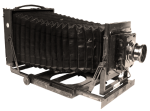Film Formats
All About Movie Film
35mm
Although motion picture film had been around in some form and in different sizes for some time, it was in the 1890s that 35mm wide film became accepted as the standard for movie production and exhibition. Other sizes have since been introduced for widescreen and large screen projection, but 35mm remains the most used gauge.
16 mm
Introduced by Kodak in 1922 as an amateur format this film was originally slit from existing 35 mm professional film stock. Sound on the film is most likely to be an optical sound track but a magnetic stripe has been used.
The format quickly gained popularity as a cheaper option for educational and training films and releases of major productions to a consumer market. The gauge is still being used today for these same purposes.
Popularity mostly waned in the 1980s and its future now is a bit shaky with distributors unwilling to release new titles in this gauge.
9.5 mm
Pathe introduced this gauge in France in 1921, just eclipsing 16 mm.
Equipment and film stock is still available and the gauge still has a strong following in some parts of the world.
Standard/Regular 8 mm
Known as both standard and regular 8 mm, this smaller gauge was released by Kodak in 1932. Again the film was slit from 16 mm stock, which by now was being made in its own size. The sprocket holes are the same size and in the same position as 16 mm, except that there was now an extra sprocket hole placed between those.
This film is best identified by looking at the position of a frame through a magnifying glass which will be between the sprocket holes. There is also very little border on the film edge opposite the sprocket holes.
Super 8 mm
Introduced by Kodak in 1965 as a totally new gauge, but still based on similar 8 mm wide film stock. The difference is that the sprocket holes are smaller allowing for the image area to be slightly increased providing for improved resolution.
The border on the film edge opposite the sprocket holes was also slightly enlarged to allow for the provision of a sound track in either optical or magnetic mediums, most likely magnetic. The frame is in line with and opposite the sprocket hole.
Single 8 mm
This gauge was introduced by Fuji in 1966 and is almost identical to Super 8 mm except that the image area is very slightly smaller. It will run in a super 8 mm projector.
All the above gauges, except single 8 mm, are still being produced today and projectors may still be available though maintenance is becoming more a problem. Popularity mostly waned when video became more available from about the mid 1970s. Theatre presentation of movies are now mostly digital. It is still possible to hire prints of older titles. There is now increasingly a return to film by some producers and directors who prefer films advantages.


